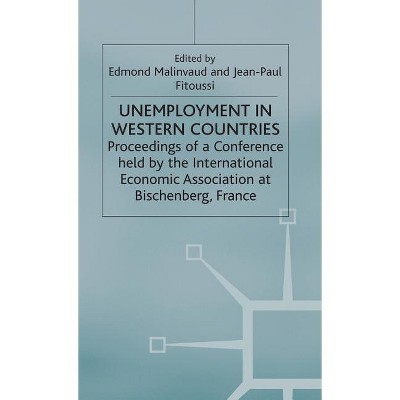Sponsored

Reducing Unemployment - by Garry K Ottosen & Douglas N Thompson (Hardcover)
In Stock
Sponsored
About this item
Highlights
- Unemployment costs the United States at least $400 billion per year in lost output.
- About the Author: GARRY K. OTTOSEN is senior research analyst of Crossroads Research Institute in Salt Lake City.
- 184 Pages
- Business + Money Management, Labor
Description
About the Book
Unemployment costs the United States at least $400 billion per year in lost output. This number does not begin to add up the total costs of unemployment that include many serious social problems like increased divorce and crime rates. If unemployment costs so much, why don't we simply pump up demand and push the unemployment rate down? The answer lies in the relationship between inflation and unemployment: we simply cannot push unemployment below the rate that is compatable with stable inflation.
Must we, then, just live with unemployment? No. But to understand how we can reduce unemployment, we must understand the nonaccelerating inflation rate of unemployment (NAIRU). What determines the level of the NAIRU? Has that level increased? Can we reduce the current NAIRU? These are important questions addressed in Reducing Unemployment Ottosen and Thompson argue that the NAIRU has increased significantly over the past 30 years. Many blame structural unemployment for that increase. Others have argued that increases in social welfare programs and payments are to blame. But hardly anyone has examined the effects of increasing government regulations on the NAIRU. Reducing Unemployment remedies this oversight, and also looks at the effects of unionization and productivity on the NAIRU. The authors conclude that the United States does not have to tolerate a high unemployment rate, for the NAIRU can be reduced through appropriate government deregulation.
Book Synopsis
Unemployment costs the United States at least $400 billion per year in lost output. This number does not begin to add up the total costs of unemployment that include many serious social problems like increased divorce and crime rates. If unemployment costs so much, why don't we simply pump up demand and push the unemployment rate down? The answer lies in the relationship between inflation and unemployment: we simply cannot push unemployment below the rate that is compatable with stable inflation.
Must we, then, just live with unemployment? No. But to understand how we can reduce unemployment, we must understand the nonaccelerating inflation rate of unemployment (NAIRU). What determines the level of the NAIRU? Has that level increased? Can we reduce the current NAIRU? These are important questions addressed in Reducing Unemployment Ottosen and Thompson argue that the NAIRU has increased significantly over the past 30 years. Many blame structural unemployment for that increase. Others have argued that increases in social welfare programs and payments are to blame. But hardly anyone has examined the effects of increasing government regulations on the NAIRU. Reducing Unemployment remedies this oversight, and also looks at the effects of unionization and productivity on the NAIRU. The authors conclude that the United States does not have to tolerate a high unemployment rate, for the NAIRU can be reduced through appropriate government deregulation.Review Quotes
?For those looking for a well written survey of the extensive literature on this topic, this book is a good place to start.?-Political Science Quarterly
?Persuasively and clearly written, the book presents an excellent explanation of the conventional view of the relationship between inflation and unemployment. The authors carefully examine each part of the theory surrounding the natural rate of unemployment, asserting that the problem of an increasing NAIRU can be solved if we look at the root causes of the increase. The reader will come away with a more complete understanding of the relationship between inflation and unemployment and the place of the NAIRU in that relationship.?-Choice
"For those looking for a well written survey of the extensive literature on this topic, this book is a good place to start."-Political Science Quarterly
"Persuasively and clearly written, the book presents an excellent explanation of the conventional view of the relationship between inflation and unemployment. The authors carefully examine each part of the theory surrounding the natural rate of unemployment, asserting that the problem of an increasing NAIRU can be solved if we look at the root causes of the increase. The reader will come away with a more complete understanding of the relationship between inflation and unemployment and the place of the NAIRU in that relationship."-Choice
About the Author
GARRY K. OTTOSEN is senior research analyst of Crossroads Research Institute in Salt Lake City.
DOUGLAS N. THOMPSON is president of Crossroads Research Institute in Salt Lake City. Both authors are recipients of the 1994 Abramson Award granted by the National Association of Business Economists in recognition of their outstanding contribution to the professional literature in the field of business economics.Shipping details
Return details
Trending Non-Fiction











